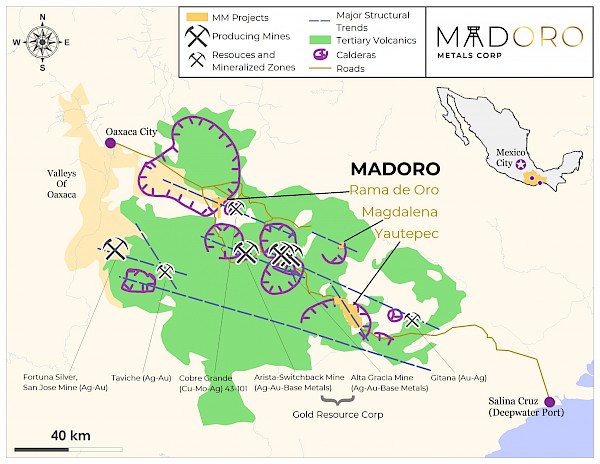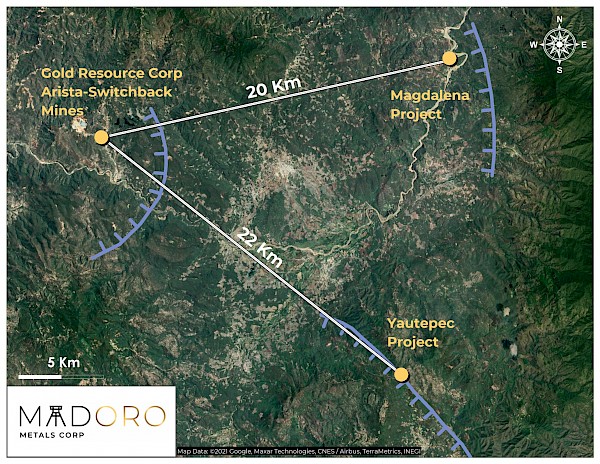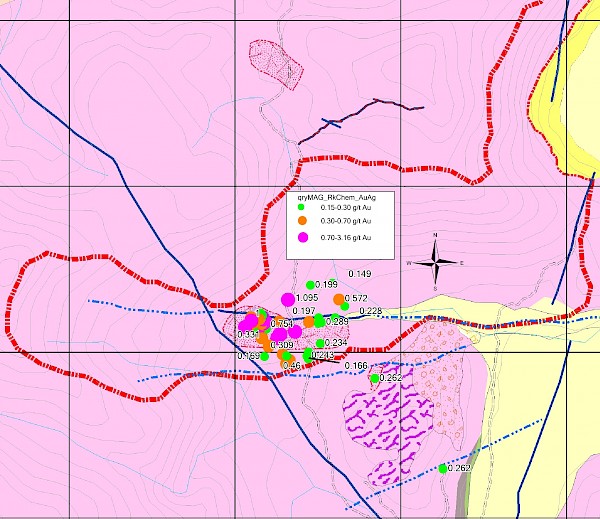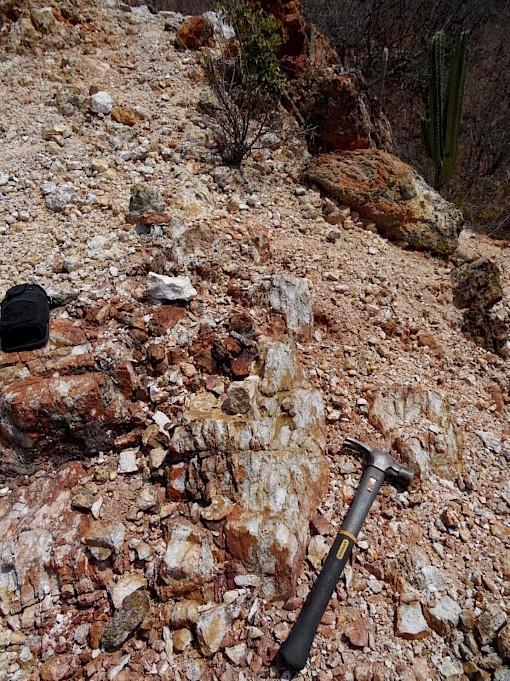Summary
| Commodity: |
Commodity:
Gold, Silver
|
| Location: |
Location:
Oaxaca, Mexico
|
| Nearest City: |
Nearest City:
Oacaxa City, 150 km (Combined Population ~ 350,000)
|
| Infrastructure: |
Infrastructure:
Good road access, modest topography, skilled labor nearby
|
| Utilities: |
Utilities:
Water and power access
|
| Labour: |
Labour:
Experienced Mexican geologists and local technical labor
|
| Communities: |
Communities:
Magdalena
|
| Size: |
Size:
480 hectares
|
| Stage: |
Stage:
Exploration
|
| Ownership: |
Ownership:
Option to acquire 100%
|
Overview
- Comprises a single 480-hectare property centered on highly altered volcanic rocks 20km southeast of Gold Resource Corp’s active Arista-Switchback Au-Ag mines and within the same regional structural trend.
- Preliminary exploration has identified a 1.7 km long East-West zone of strong quartz veining, rhyolite diking, and associated clay, gypsum, and oxidized sulfide alteration.
- Mapping and rock chip sampling reveal a 300 by 285 meter principal mineralized zone defined by 58 samples with greater than 0.20 g/t Au, including two above 3.0 g/t Au and 12 above 1.00 g/t Au.
- Multiple outlying target areas have been identified and require follow-up evaluation and are easily accessed and drill-ready using man-portable rigs.
- No history of systematic exploration or drilling in the area.
Geology
Extensive felsic tuffs mapped by SGM have been interpreted as a caldera setting, similar to that of the Gold Resource Corporation’s mine area and Megastar’s recently acquired Rama de Oro Project. The area of coincident metals anomalies, clay and silica alteration, sulfate (gypsum) deposition, and minor rhyolite diking, lies along a prominent NW-SE structural trend (SGM mapping) adjacent to an inferred caldera margin. The presence of various types of chalcedonic and vuggy silica, elevated pathfinder metals (Hg, As), and extensive sulfate deposition (gypsum) indicates exposures at the highest levels of an anomalous Au-Ag- base metal system of excellent exploration potential.
Exploration
Over a period of two months’ field mapping and sampling, 277 rock chip samples were taken in areas of extensive epithermal alteration along the eastern structural margin of a recently identified Tertiary caldera. Epithermal alteration minerals include clays, quartz veining/silicification, oxidized sulfides, barite, and gypsum. Significant results are shown in the following table:
Magdalena Project: Significant sample results (ALS Labs) from first two work periods (n=277)
| Element | Maximum values | Lithology of highest value | Samples with Significant values | |
|---|---|---|---|---|
| Precious metals | Ag | 3.16 and 3.12 g/t |
Quartz veins | 12 > 1.00 g/t 24 > 0.50 g/t 59 > 0.20 g/t |
| Au | 64.30 g/t | Quartz vein | 12 > 10.00 g/t | |
| Base metals | Cu | 312 ppm | Rhyolite dome | 11 > 50 ppm |
| Pb | 1.27% | Quartz vein | 13 > 1000 ppm 22 > 500 ppm |
|
| Zn | 4520 ppm | Quartz veined rhyolite | 3 > 1000 ppm 14 > 200 ppm |
|
| Mo | 85.7 ppm | Veined rhyolite | 18 > 20 ppm | |
| Pathfinder elements | As | 5140 ppm | Quartz vein | 14 > 1000 ppm 41 > 500 ppm |
| Ba | 2850 ppm | Silicified vein breccia | 6 > 2000 ppm 29 > 1000 ppm |
|
| Hg | 12.0 ppm | Clay altered tuff | 29 > 1.0 ppm | |
| Sb | 1135 ppm | Quartz veined tuff | 7 > 100 ppm 15 > 50 ppm |
|
| Se | 770ppm | Brecciated quartz vein | 26 > 50 ppm | |
| Te | 31.0 ppm | Silicified volcanic | 38 > 1.0 ppm | |
| Tl | 3.38 ppm | Silicified rhyolite | 34 > 1.0 ppm |
The tabulated results (above) indicate the system is strongly anomalous in precious metals, base metals, and epithermal pathfinder elements. The lithologic, alteration, and geochemical character of the system is similar to that of the nearby producing Arista-Switchback mines of Gold Resource Corporation.
Exploration Potential
Magdalena has all of the characteristics of a significant epithermal system including gold mineralization locally exceeding 3.00 grams per tonne (g/t). The Project lies in the central portion of the Oaxaca Au-Ag polymetallic epithermal belt in the Sierra Madre del Sur, Mexico, 20 kilometers east-northeast of Gold Resource Corporation’s Arista-Switchback Mine, and 22 kilometers south of the Company’s Yautepec project (see news releases dated July 16, 2019 and August 22, 2019).
Strong epithermal alteration is found along a minimum 1.7 km long E-W structural trend that shows sheeted quartz vein sets and silicification in conjugate NNW to NNE-NE structural sets. The setting is the eastern structural margin of a caldera where it intersects a prominent regional E-W structural trend. Approximately 4,100 square meters of silicified bladed calcite textures have been mapped within a larger area of strong and sheeted quartz veining. Both samples above 3.00 g/t gold, all 12 samples above 1.00 g/t gold, and 54 of 59 samples above 0.20 g/t gold lie within the larger quartz veined area of approximately 375 meters E-W by 190 meters N-S. Mound-like silica forms within 250 meters of this area are interpreted as silicified hot spring stromatolites (i.e. a paleosurface), suggesting that the entire vertical extent of the potential bonanza grade mineralized system, if present, may be conserved at depth.
The Magdalena Project presence has seen no significant historic exploration or drilling.
Work Plan
Madoro has mapped a principal 300 by 285 meter area of surface gold mineralization defined by 58 samples above 0.20 g/t, which include two samples above 3.00 g/t gold, and 12 samples above 1.00 g/t gold. This main zone, along with other prominent outliers, constitute easy-to-access and drill-ready targets.
Rob Johansing, M.S., C.P.G. Consulting Geologist, a qualified person in accordance with NI 43-101, has reviewed and accepted the technical information in this news release.





